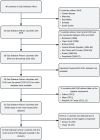Effects of household access to water, sanitation, and hygiene services on under-five mortality in Sub-Saharan Africa
- PMID: 37181724
- PMCID: PMC10173862
- DOI: 10.3389/fpubh.2023.1136299
Effects of household access to water, sanitation, and hygiene services on under-five mortality in Sub-Saharan Africa
Erratum in
-
Corrigendum: Effects of household access to water, sanitation, and hygiene services on under-five mortality in Sub-Saharan Africa.Front Public Health. 2023 Sep 28;11:1280610. doi: 10.3389/fpubh.2023.1280610. eCollection 2023. Front Public Health. 2023. PMID: 37841723 Free PMC article.
Abstract
Introduction: Sub-Saharan Africa has the highest under-five mortality rate and is among the regions where people have the least access to adequate Water, Sanitation, and Hygiene (WASH) services. The work aimed to investigate the effects of WASH conditions faced by children on under-five mortality in Sub-Saharan Africa.
Methods: We carried out secondary analyses using the Demographic and Health Survey datasets of 30 countries in Sub-Saharan Africa. The study population consisted of children born within 5 years preceding the selected surveys. The dependent variable was the child's status (1 = deceased versus 0 = alive) on the survey day. The individual WASH conditions in which children live were assessed in their immediate environment, i.e., at the level of their households of residence. The other explanatory variables were related to the child, mother, household, and environment. Following a description of the study variables, we identified the predictors of under-five mortality using a mixed logistic regression.
Results: The analyses involved 303,985 children. Overall, 6.36% (95% CI = 6.24-6.49) of children died before their fifth birthday. The percentage of children living in households with access to individual basic WASH services was 58.15% (95% CI = 57.51-58.78), 28.18% (95% CI = 27.74-28.63), and 17.06% (95% CI = 16.71-17.41), respectively. Children living in households using unimproved water facilities (aOR = 1.10; 95% CI = 1.04-1.16) or surface water (aOR = 1.11; 95% CI = 1.03-1.20) were more likely to die before five than those coming from households with basic water facilities. The risk of under-five mortality was 11% higher for children living in households with limited sanitation facilities (aOR = 1.11; 95% CI = 1.04-1.18) than for those with basic sanitation services. We found no evidence to support a relationship between household access to hygiene services and under-five mortality.
Conclusion: Interventions to reduce under-five mortality should focus on strengthening access to basic water and sanitation services. Further studies are needed to investigate the contribution of access to basic hygiene services on under-five mortality.
Keywords: Sub-Saharan Africa; child; demographic and health survey; household; hygiene; sanitation; under-five mortality; water.
Copyright © 2023 Gaffan, Kpozehouen, Degbey, Ahanhanzo and Paraïso.
Conflict of interest statement
The authors declare that the research was conducted in the absence of any commercial or financial relationships that could be construed as a potential conflict of interest.
Figures
Similar articles
-
Exploring the association between household access to water, sanitation and hygiene (WASH) services and common childhood diseases using data from the 2017-2018 Demographic and Health Survey in Benin: focus on diarrhoea and acute respiratory infection.BMJ Open. 2023 Sep 19;13(9):e074332. doi: 10.1136/bmjopen-2023-074332. BMJ Open. 2023. PMID: 37730407 Free PMC article.
-
Effects of the level of household access to water, sanitation and hygiene on the nutritional status of children under five, Benin.BMC Nutr. 2023 Aug 1;9(1):95. doi: 10.1186/s40795-023-00751-8. BMC Nutr. 2023. PMID: 37528455 Free PMC article.
-
Household access to basic drinking water, sanitation and hygiene facilities: secondary analysis of data from the demographic and health survey V, 2017-2018.BMC Public Health. 2022 Jul 14;22(1):1345. doi: 10.1186/s12889-022-13665-0. BMC Public Health. 2022. PMID: 35836162 Free PMC article.
-
Water, sanitation and hygiene (WASH) in sub-Saharan Africa and associations with undernutrition, and governance in children under five years of age: a systematic review.J Dev Orig Health Dis. 2021 Feb;12(1):6-33. doi: 10.1017/S2040174419000898. Epub 2020 Jan 6. J Dev Orig Health Dis. 2021. PMID: 31902390
-
Delivering water, sanitation and hygiene interventions to women and children in conflict settings: a systematic review.BMJ Glob Health. 2020 Jul;5(Suppl 1):e002064. doi: 10.1136/bmjgh-2019-002064. BMJ Glob Health. 2020. PMID: 32641288 Free PMC article.
Cited by
-
A tool for the assessment of the risk drivers and public perception of WASH in South Africa.Jamba. 2024 Oct 31;16(2):1782. doi: 10.4102/jamba.v16i2.1782. eCollection 2024. Jamba. 2024. PMID: 39512860 Free PMC article.
-
High Child Mortality and Interventions Coverage in the City of Dar es Salaam, Tanzania: Are the Poorest Paying an Urban Penalty?J Urban Health. 2024 Nov;101(Suppl 1):92-106. doi: 10.1007/s11524-023-00813-z. Epub 2024 Jan 12. J Urban Health. 2024. PMID: 38216824 Free PMC article.
-
Analysis of Under-Five Mortality Rate in Saudi Arabia: 1973 to 2022.Cureus. 2025 Jan 27;17(1):e78048. doi: 10.7759/cureus.78048. eCollection 2025 Jan. Cureus. 2025. PMID: 40013168 Free PMC article.
-
Economic and healthcare determinants of under-five mortality in low-income countries.BMC Public Health. 2025 Jun 6;25(1):2126. doi: 10.1186/s12889-025-23370-3. BMC Public Health. 2025. PMID: 40481432 Free PMC article.
-
Statistical models for predicting the number of under-five mortality in Nepal.PLoS One. 2025 May 21;20(5):e0324321. doi: 10.1371/journal.pone.0324321. eCollection 2025. PLoS One. 2025. PMID: 40397896 Free PMC article.
References
-
- You D, Hug L, Ejdemyr S, Idele P, Hogan D, Mathers C, et al. . United Nations inter-agency Group for Child Mortality Estimation. Global, regional, and national levels and trends in under-5 mortality between 1990 and 2015, with scenario-based projections to 2030: a systematic analysis by the UN inter-agency Group for Child Mortality Estimation. Lancet Lond Engl. (2015) 386:2275–86. doi: 10.1016/S0140-6736(15)00120-8 - DOI - PubMed
MeSH terms
Substances
LinkOut - more resources
Full Text Sources




